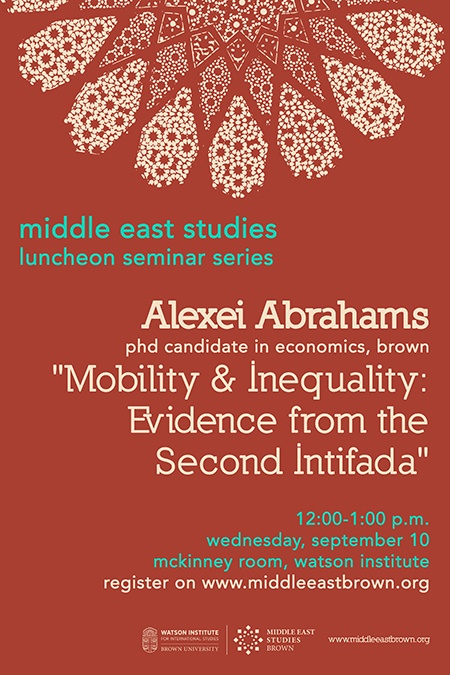Wednesday, September 10, 2014
12 p.m. – 1 p.m.
McKinney Conference Room, Watson Institute
Registration is now open. You can register below.
Speaker: Alexei Abrahams, PhD Candidate at Brown University's Economics Department
This paper finds that mobility disruption of a commuter economy tends to exacerbate preexisting spatial economic inequalities. I study the Palestinian West Bank, 1997-2007, a small inland territory possessing a highly active commuter economy where laborers travel regularly between their hometowns and places of work. Starting in 2002, amidst a violent uprising, the Israeli army deployed numerous security obstacles (checkpoints, roadblocks, walls) along the West Bank's internal road network, disrupting commuter traffic. I provide strong empirical evidence to complement a well known claim that obstacle placement was motivated by a desire to intercept and deter Palestinian traffic in the vicinity of Israeli civilian settlements. As such, the placement of obstacles generated "quasirandom" increases to transit costs between Palestinian towns. Among towns whose commuter flow was obstructed, economic consequences varied: towns with low initial employment rates suffered significant employment losses, while those with high initial employment rates sometimes enjoyed employment increases. There is some evidence that net-immigration rates and satellite nighttime light emissions responded similarly. I interpret these results with a core-periphery commuting model, where most jobs are offered in a handful of large, 'core' cities (such as Ramallah, Nablus, Hebron). Peripheral villages are dependent on the core for work opportunities. Increases to transit costs make commuting less feasible, causing peripheral laborers to give up their jobs in the core. These job vacancies are seized upon by core-dwelling laborers, thus raising employment rates in the core, while also inducing immigration from the periphery to the core. Increased transit costs therefore exacerbate economic inequality between the core and periphery. Relevant to Palestinian nation building, if these transit costs persist then the long-term impoverishment of peripheral areas will tend to induce periphery-to-core migration, crowding core cities while leaving peripheral villages vulnerable to annexation.

